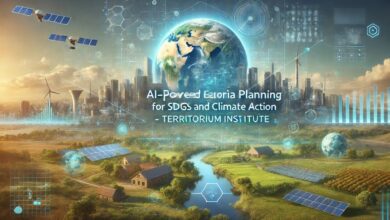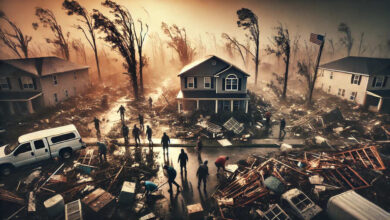Hurricanes and Climate Action Topical Authority for Local Governments: Perplexity.ai_SDG-Space

- 1. Local Climate Action in the Wake of Helene and Milton
- 2. Disaster Preparedness and Resilience for Local Governments
- 3. Local Infrastructure and Climate Adaptation
- 4. Local Economic Recovery and Climate-Smart Development
- 5. Local Governments and COP29 Participation
- 6. Citizen Engagement in Local Climate Action
- 7. Sustainable Urban Development in a Changing Climate
- 8. Financing Local Climate Action
- 9. Inter-Municipal Cooperation on Climate Change
- 10. Measuring and Reporting Local Climate Action
Monstrous hurricanes Helene and Milton caused so much complex havoc that damages are still being added up, but government and private experts say they will likely join the infamous ranks of Katrina, Sandy and Harvey as super costly $50-billion-plus killers.
Making that even more painful is that most of the damage – 95% or more in Helene’s case – was not insured, putting victims in a deeper financial hole.
Storm deaths have been dropping over time, although Helene was an exception. But even adjusted for inflation, damages from intense storms are skyrocketing because people are building in harm’s way, rebuilding costs are rising faster than inflation and human-caused climate change are making storms stronger and wetter, experts in different fields said.
“Today’s storms, today’s events are simply vastly different from yesterday’s events. One of the things that we’re seeing is the energy content that these systems can retain is significantly greater than it used to be,” said John Dickson, president of Aon Edge Insurance Agency, which specializes in flood coverage. “The weather seems to be, in many cases, moving faster than we as a society are able to keep pace with it.”
In the last 45 years, and adjusted for inflation, the National Oceanic and Atmospheric Administration has counted 396 weather disasters that caused at least $1 billion in damage. Sixty-three of those were hurricanes or tropical storms.
The $50 billion mark for direct losses is a threshold that differentiates “truly historic events,” said Adam Smith, the economist and meteorologist who runs the list out of NOAA’s National Center for Environmental Information in Helene-hit Asheville, North Carolina.
Only eight hurricanes reached that threshold. Smith said he thought Milton and Helene have “a very good shot” of joining that list.
Don’t you think that these two latest events represent a good primer for an interesting topical authority on climate change, SDG 13 specifically? Don’t you think so?
Local governments indeed play a pivotal role in climate action, and the recent hurricanes Helene and Milton, along with the upcoming COP29, provide an excellent context for addressing this at the local level. Let’s design a cluster structure specifically for local governments, focusing on climate action, disaster preparedness, and the connection to COP29.Here’s a proposed cluster structure for local governments:
1. Local Climate Action in the Wake of Helene and Milton
- “From Global to Local: How Hurricanes Helene and Milton Are Reshaping Municipal Climate Strategies”
- “City-Level Climate Risk Assessments: Lessons from Recent Hurricane Impacts”
- “Local Government Responses to Helene and Milton: Best Practices and Lessons Learned”
2. Disaster Preparedness and Resilience for Local Governments
- “Building Local Resilience: Municipal Strategies for Hurricane Preparedness”
- “Early Warning Systems at the City Level: Innovations After Helene and Milton”
- “Community-Based Disaster Response: Empowering Neighborhoods in the Face of Hurricanes”
3. Local Infrastructure and Climate Adaptation
- “Climate-Resilient Urban Planning: Redesigning Cities After Helene and Milton”
- “Green Infrastructure Solutions for Flood Management in Municipalities”
- “Upgrading Local Water Management Systems for Extreme Weather Events”
4. Local Economic Recovery and Climate-Smart Development
- “Economic Recovery Strategies for Hurricane-Affected Municipalities”
- “Green Job Creation at the Local Level: Opportunities in Post-Hurricane Reconstruction”
- “Climate-Smart Municipal Budgeting: Balancing Recovery and Long-Term Resilience”
5. Local Governments and COP29 Participation
- “From City Hall to COP29: How Local Governments Can Influence Global Climate Talks”
- “Implementing COP29 Outcomes at the Municipal Level: A Roadmap for Local Leaders”
- “Building Local-Global Partnerships: Connecting Cities with International Climate Initiatives”
6. Citizen Engagement in Local Climate Action
- “Participatory Climate Action Planning: Engaging Citizens in Municipal Strategies”
- “Local Climate Education Initiatives: Raising Awareness in the Community”
- “Volunteer Programs for Local Disaster Preparedness and Response”
7. Sustainable Urban Development in a Changing Climate
- “Rethinking Urban Mobility After Helene and Milton: Sustainable Transportation Solutions”
- “Energy Efficiency in Municipal Buildings: Leading by Example in Climate Action”
- “Urban Agriculture and Food Security: Local Solutions for Climate Resilience”
8. Financing Local Climate Action
- “Accessing Climate Finance for Municipalities: Navigating International Funding Opportunities”
- “Innovative Local Funding Mechanisms for Climate Adaptation Projects”
- “Public-Private Partnerships for Climate Resilience at the City Level”
9. Inter-Municipal Cooperation on Climate Change
- “Regional Climate Alliances: Strengthening Cooperation Between Neighboring Municipalities”
- “Knowledge Sharing Networks: How Cities Learn from Each Other’s Climate Experiences”
- “Transboundary Climate Action: Coordinating Efforts Across Municipal Borders”
10. Measuring and Reporting Local Climate Action
- “Local Climate Action Metrics: Measuring Progress at the Municipal Level”
- “Voluntary Local Reviews (VLRs): Aligning Municipal Efforts with Global SDGs”
- “Data-Driven Decision Making for Local Climate Policies”
This structure addresses the critical role of local governments in climate action, particularly in light of recent hurricane events and the upcoming COP29. It covers various aspects of local climate action, from disaster preparedness and infrastructure adaptation to citizen engagement and financing, all while maintaining a connection to global climate initiatives like COP29.




